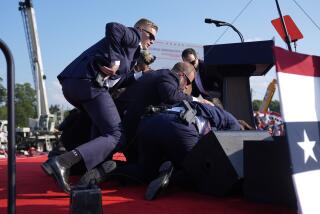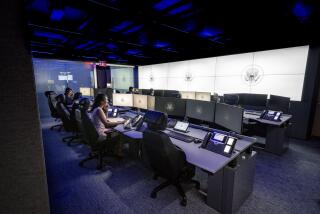Shadow Government’s Secret Is Out; Officials Want It Back In
A SECURE UNDISCLOSED LOCATION--There are secrets here in the countryside outside Washington, but they are not well kept. In this verdant land, streams run clear, fish leap and secrets leak.
At undisclosed locations far enough from the capital to survive a nuclear blast, a hidden federal government is at work, scores of officials swallowed up by the hills.
They toil in rocky warrens, micro-Washingtons stuffed into tunnels, with communication links, emergency food rations and stale air.
The government won’t say where they are.
The problem is, lots of other people are sure they know.
The government kept a tight lid on the locations of its bombproof emergency centers outside the capital until the Cold War ended and everyone relaxed. Now facing terrorist threats, Washington is trying to take these secrets back.
But these installations have neighbors over the barbed-wire fence. Satellite pictures are available. And how hush-hush can anything be when motor mouths talk about it online?
“It’s simply a matter of connecting the dots,” said Steven Aftergood of the Federation of American Scientists.
An unofficial tour around one such site was provided by a civil servant who works in an unrelated part of the government. He lives hereabout and is well-connected to hamlets in the vicinity.
He will be known as Deep Trout.
“It’s an underground bunker,” he says, pointing to a hilltop on a horizon etched by radio towers. “Everyone knows that. It’s like trying to put the genie back in the bottle.”
On Thanksgiving, he took his kids up a nearby hill that also has communication equipment. Previous outings caused no trouble. This time, military police confronted them in a hurry.
He asked one guard what was going on. “The guy said, ‘If I tell you I’ll have to kill you.’
“He was smiling,” Deep Trout added.
People grew up here knowing they had a mysterious federal installation in their midst--the one up the slope where tunnels go straight into rock and seem never to come out.
“Half the country knows about it,” says Bobbi, a homeowner whose yard borders the federal property down a winding lane.
If not half the country, then surely half the countryside.
“You hear more things than normal people up here,” says Julie, pausing in the stockroom of her family’s grocery store.
But she’s not too nosy when people come in from the mountain. “I don’t think that’s fair that I ask them and put them in a predicament which they shouldn’t be in. Their job’s secret.”
People joke they expect to run into Vice President Dick Cheney, often said to be hunkered down in secure undisclosed locations after Sept. 11.
Residents who were interviewed gave their full names and other particulars. Those details, like Deep Trout’s identity, are not being reported, to avoid giving away the location.
The White House says as many as 150 officials from every Cabinet agency work in two sites, staying on the compounds 24 hours a day until they rotate out and others replace them, under a plan tailored to the terrorist threat.
Their basic needs are met. In Deep Trout’s territory, there is no call and perhaps no opportunity to venture to the local restaurant for the rustic specialty, hog maw.
A citizen who has frequently delivered supplies inside said the facilities are Spartan, with heavy desks the color of battleships and the air not country fresh. “Typical ‘50s decor,” the supplier said.
New furniture is being rushed in. The tunnel leading to the multistory underground offices has a massive door, then another, and the two are never opened at the same time, the supplier said.
The second site that national security experts believe is also home to the hidden government is several hours away.
It’s a hive of activity at the crest of a hill. A helicopter roars from the pad, traffic flows past the gate. An officer questions two people taking pictures by the road, checks their identification and encourages them to move on.
Among the secure federal facilities arcing around Washington, two have been documented as primary backups for the Pentagon and a cross-section of federal agencies. They can house large numbers of officials indefinitely; declassified plans for one of them, from 1951, called for office space for 5,400 people.
“By refusing to identify the locations, the government may actually be creating a mystique around the facilities and encouraging speculation, curiosity,” Aftergood said.
There was once plenty of mystique surrounding an elaborate bunker secretly built for members of Congress under the Greenbrier resort in West Virginia.
After the Cold War, when the risk of a nuclear attack eased, it came to be seen as a relic and its functions were detailed in the media. Now the public can tour it.
In Deep Trout country, Jill steps out of the fragrance of her quilt, birdhouse and curio store to look out on the secret mountain. “It was a little scary being here when things went down in September,” she said.
On Sept. 11, the skies thickened with fighter jets and helicopters, and that has happened many times since. Roads were blocked and parents could not immediately reach their kids at school.
The crisis in America’s stricken cities had come to the quiet hills.
After that, everyone was jumpy.
When teenage hikers and a teacher on a school field trip drifted off their trail in October and came too close to the federal site, camouflaged men with guns stopped them.
Another teacher, watching from a distance, called police to say somebody was holding his students at gunpoint. Everything was sorted out.
Then there was the “white van” incident.
“That was the day they spotted the Arabs,” said Bobbi. “We were out of here in five minutes.”
Men in a van had raised suspicions, and authorities told residents to watch for danger. It was apparently a misunderstanding of some sort and no more was said about it.
“We never find out,” Jill said. “We never know the results.”
More to Read
Sign up for Essential California
The most important California stories and recommendations in your inbox every morning.
You may occasionally receive promotional content from the Los Angeles Times.










